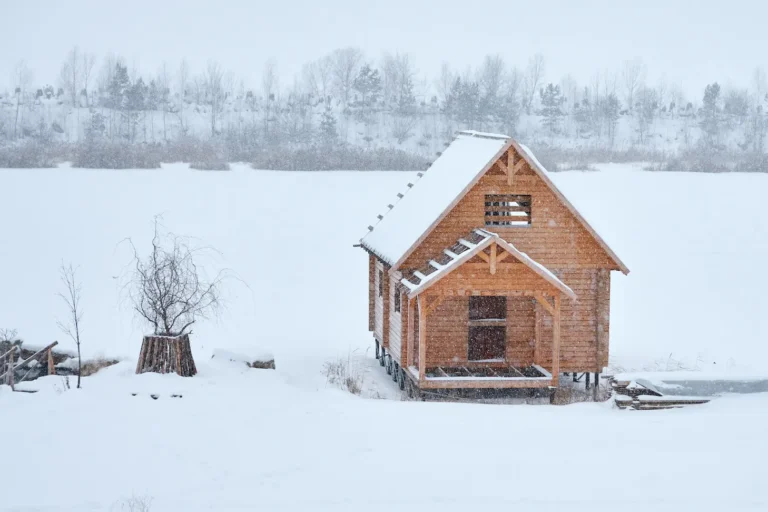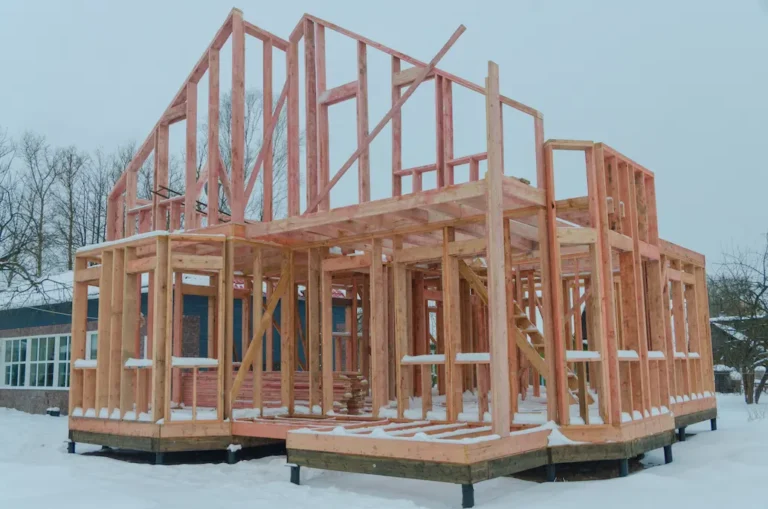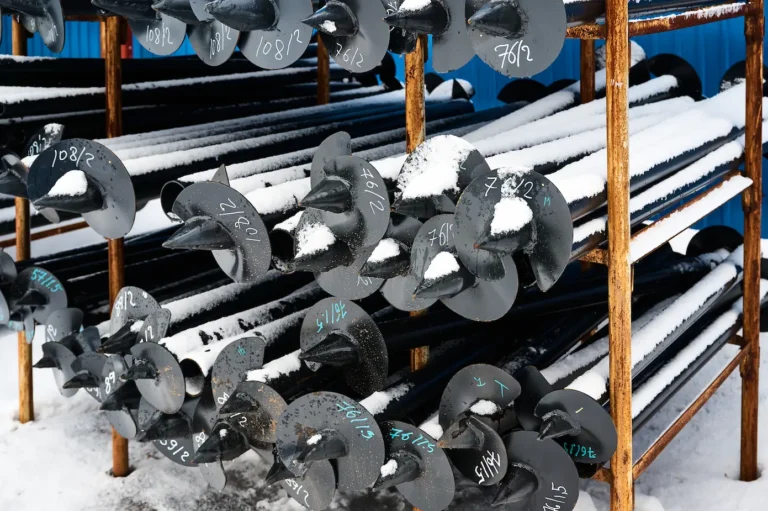Is helical pile installation in winter possible? When the ground is completely frozen, most homeowners assume construction has to wait until spring. But is it really too late or too risky to start any kind of foundation work? After all, how could you possibly drill or anchor anything into a frost-hardened land?
Well, in Canadian soil, it is a common belief that winter brings construction to a halt, especially for anything involving structural support. However, that’s not always true.
Winter doesn’t always mean a pause. In fact, for certain types of work, like the installation of helical piles, the cold might not be the obstacle you think it is.
- In the following paragraphs, you will learn how modern equipment and experienced helical pile installers work efficiently even when the ground is frozen.
We also cover the benefits of cold-season installations, potential challenges to be aware of, and tips to ensure your project goes as planned, no matter the temperature.

Can you install helical piles in winter?
Absolutely, helical pile installation in winter is not only possible, it’s a practical, proven technique. Even when the conditions are not optimal, snow, ice, or cold, there is no problem.
- These piles are designed to be installed 365 days a year.
- Experienced installers get the job done quickly and safely.
- Believe it or not, frozen ground even helps, offering more consistent soil conditions for the install.
Sure, winter slows down some types of construction, but not this one. Helical piles are different! Since they don’t rely on curing time like concrete, there’s no waiting around in the cold. With the right tools and expertise, the foundation is ready to build on right away without having to wait for warmer weather.
All you need is a team that knows what they’re doing in cold conditions.
What are the benefits of installing helical piles in winter?
You might be surprised to learn that winter installation actually comes with some real advantages.
- For starters, helical piles are ready to support your structure immediately after installation.
- They’re designed to penetrate frozen ground with ease.
- Specialized machinery screws the piles deep below the frost line, so winter conditions don’t get in the way.
- Even in the snow, the installation process is flexible and efficient, requiring minimal excavation and cleanup.
The more we think about it, the more we notice that winter is a smart time to build. Do you want to know why? You’ll likely avoid the typical spring and summer construction delays. When contractors are swamped and timelines get pushed back. With fewer projects happening, you will enjoy more scheduling opportunities.
If you are ready to move forward, winter might just be the perfect time to start.
What are the common applications of helical pile installations in winter?
While helical piles can be installed anytime, some projects are more likely to be scheduled in December, January, February and March than others.
It’s more popular for larger commercial or industrial projects as they are often required to stay on a tight schedule. However, that doesn’t mean they’re off-limits for residential builds. Far from it.
More precisely, in winter, helical piles are often used to:
- Create a new foundation
- Stabilize an existing structure
- Support a lightweight structure
- Build a temporary structure
Over time, the colder months become less of a barrier and more of a window of opportunity.

Concrete foundation vs Helical piles - How does winter affect installation methods?
The difference between a concrete foundation and helical piles is night and day.
Cold temperatures and frost seriously complicate concrete work. Curing slows down, ground prep becomes tricky, and there’s always the risk of cracking or degradation. That’s why many contractors prefer helical piles when the weather turns cold.
Piles are simply way more winter-friendly. They’re fast to install, require no curing time, and are drilled right into frozen ground without delay. That means a smoother overall process.
Here’s an overlook at how they compare in cold weather:
- Piles allow a quicker project completion.
- Piles have resilience in extreme cold weather.
- Concrete foundations are susceptible to cracking and degradation in freezing temperatures.
- Piles lead to fewer unexpected costs.
- Without having to excavate the soil, there is less environmental invasion and minimal disruption to the surroundings.
For winter builds, helical piles just make sense, that’s all.
Winter installation tips for helical piles
Installing helical piles in winter can be just as smooth, if not smoother, than during other seasons. Well, as long as a few key steps are followed.
What is the first thing to do? Clear the snow from the site. It sounds obvious, but it’s essential. Removing snow gives the crew proper access to the ground and ensures accuracy during installation.
After the removal of the snow, if the frost is particularly thick, pre-drilling a small pilot hole allows the team to break through the ice layer and make it easier to proceed with the pile.
Working with experienced contractors who know the ins and outs of winter installs is required. They come prepared with the right equipment and techniques and are ready to handle whatever Mother Nature throws their way.

FAQ - Most frequently asked questions about helical pile installation in winter
Are helical piles more expensive to install in winter?
It’s a fair question to ask, as many people assume that doing any kind of construction in winter automatically costs more. That’s not necessarily the case because the price usually stays pretty consistent from one season to another.
However, in some cases, installing piles in winter saves you money. How? Contractors tend to be less busy in colder months, which might give you more flexibility and better scheduling rates.
So if you’re worried about a seasonal price hike, don’t be. Installing helical piles in winter is not just doable, it’s often a smart investment to make.
Can frozen ground affect or damage helical piles?
It’s easy to assume that frozen ground would be a problem for any foundation system, but helical piles are built to handle it. They’re specifically designed to be installed below the frost line, where the ground stays stable year-round, even in harsh Canadian winters.
On the surface, frozen ground seems intimidating, but once the pile is driven deep enough, it reaches soil that isn’t affected by freezing and thawing. That’s what gives it long-term stability. The piles themselves are made of galvanized steel, which is tough, durable, and built to resist corrosion and ground movement.
So no, frozen ground won’t damage your piles. If anything, the compacted nature of winter soil even helps with installation accuracy.
How do I find the right contractor for winter helical pile installation?
Finding the right installer for winter helical pile work takes a bit of thoughtful research.
- First, look for experience in cold-weather projects. Contractors who advertise winter installs have handled frozen-ground challenges before.
- Next, ask about their winter preparation methods. An experienced team will clear snow, use pilot holes or even localized thawing to break through ice before driving piles. That shows they know how to prevent delays and protect your site.
- Third, make sure they’re local or have a nearby dealer network because shorter travel means faster service and better efficiency.
When the three steps are complete, take the time to read reviews or ask for referrals, specifically mentioning winter installations.
If you are looking for a referral, our team will be happy to assist you and put you in contact with the most experienced winter installer.
Will winter installation disrupt the surrounding environment?
Helical pile installations are notably gentle on the environment. Unlike traditional methods, this one requires minimal soil disturbance. This approach helps preserve the natural landscape, protecting plant roots and local ecosystems from unnecessary disruption.
The installation process is also designed to be vibration-free, reducing the risk of damaging nearby structures or disturbing wildlife. Additionally, since helical piles are made of steel, they are highly recyclable, contributing to a reduction in construction waste and promoting sustainability.
Opting for helical piles during winter installations not only ensures a stable foundation but also aligns with eco-friendly construction practices.
Don’t wait for spring - Secure your helical pile installation in winter now!
Don’t wait months to get started, secure your helical pile installation and keep your project on track.
Ready to help you with expert service, competitive pricing, and answers to all your questions, our local partners are standing by to respond to your request.
- Fill out our form to receive free quotes and connect with professionals who know how to handle winter conditions with absolute confidence.
No matter the season or the weather, make it happen!


